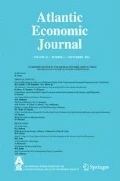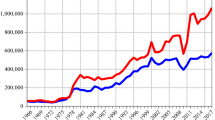Abstract
This paper estimates growth models for a panel of 15 Asian countries during 40-plus years from the early 1970s to 2014. The focus then shifts to Malaysia for which an annual time-series model is also estimated for the same time period. Both types of models indicate significant influence of human capital either directly on output growth or on growth through total factor productivity. We find that the lower the development level of a country (i.e., a greater income gap), the greater the total factor productivity growth which therefore permits faster income convergence. There is some evidence of interaction between human capital and the income gap as well which leads to an even bigger impact of human capital on total factor productivity growth. The interaction between human capital and openness produces a greater effect on growth in Malaysia based on the time-series model than its effect based on the panel model. Our results suggest that, barring large external shocks, a continued focus on human capital development should help to prevent growth slowdown in Malaysia over the next 15 years.



Similar content being viewed by others
Notes
See Figure 1 for real GDP growth for two sub-periods.
The faster growth in Singapore was partly due to larger growth in population in the second period resulting from a higher immigration rate. In per capita terms, real growth in Singapore fell marginally from 5.8% to 5.7%.
Park (2012) used India’s labor share for Pakistan and Thailand’s share for Vietnam. His sample did not include Bangladesh or Nepal.
The PWT labor share is almost identical with 0.56 for 10 Asian countries estimated by Das (2014).
An alternative, the Im-Pesaran-Smith test of panel stationarity, cannot be carried out for fewer than 10 observations per country.
Indeed, the level variables are found to be nonstationary with one unit root in them.
Data availability was also a problem. Despite accessing data from a number of sources including PWT9 (Feenstra et al. 2015; Penn World Tables 9.0, 2015), World Development Indicators (World Bank 2016), World Economic Outlook (International Monetary Fund 2016, 2018b), and (Organization for Economic Cooperation and Development 2016), even a relatively non-comprehensive model could only be estimated with a third of total observations in the dataset. For instance, our preferred model with only six explanatory variables (human capital, the catchup term, human capitalcatchup interaction, openness, M2-GDP ratio (Broad Money as percent of GDP), and R&D expenditure-GDP ratio, with a lag in some cases) retained only 45 out of 135 observations in the sample. This would be just three observations per country, mainly due to scarce R&D data, and hence would make the estimated results inefficient and suspect.
Of course, life expectancy and under-five mortality both indicate overall health situation in a country and cannot both be included in the same regression. The correlation between these two variables is 0.90.
Domestic credit is only one of the important indicators of financial development together with several other variables, such as broad money, and stock market capitalization. Growth should be positively correlated with overall financial development for a poor but growing economy, yet literature has not firmly established such a correlation for countries with a high degree of financial development. Is the relationship nonlinear, particularly because there is a threshold below which economic growth and financial development are correlated and not otherwise? Can all the indicators of financial development be combined in an orthogonal fashion in terms of principal components that can then be used to explore the relationship between finance and GDP growth? These questions are left for future research.
Increases in human capital have remained below 0.04 in all years except for 13 years from 1983 through 1995.
References
Acemoglu, D., & Johnson, S. (2007). Disease and development: The effect of life expectancy on economic growth. Journal of Political Economy, 115(6), 925–985.
Anand, R., Cheng, K., Rehman, S., and Zhang, L. (2014). “Potential Growth in Emerging Asia.” IMF Working Paper WP 14/2. https://www.imf.org/en/Publications/WP/Issues/2016/12/31/Potential-Growth-in-Emerging-Asia-41198 .
Arora, V., & Vamvakidis, A. (2005). How much do trading partners matter for economic growth? IMF Staff Papers, 52(1).
Bernanke, B., and Gurkaynak, R. (2001). “Is Growth Exogenous? Taking Mankiw, Romer and Weil Seriously,” NBER Working Paper 8365 (Cambridge, MA: National Bureau of Economic Research).
Bosworth, B. P., & Collins, S. M. (2003). The empirics of growth: An update. Brookings Paper on Economic Activity, 2, 113–206 https://www.brookings.edu/wp-content/uploads/2003/06/2003b_bpea_bosworth.pdf.
Brynjolfsson, E., Rock, D., & Syverson, C. (2018). "artificial intelligence and the modern productivity paradox: A clash of expectations and statistics," NBER chapters. In The economics of artificial intelligence: An agenda (pp. 23–57). Inc: National Bureau of Economic Research.
Cervellati, M., & Sunde, U. (2011a). Disease and development: The role of life expectancy reconsidered. Economics Letters, 113(3), 269–272.
Cervellati, M., & Sunde, U. (2011b). Life expectancy and economic growth: The role of the demographic transition. Journal of Economic Growth, 16(2), 99–133.
Ciccone, A., & Jarocinski, M. (2010). Determinants of economic growth: Will data tell? American Economic Journal: Macroeconomics, 2(4), 222–246.
Crafts, N. (1999). East Asian growth before and after the crisis. IMF Staff Papers, 49(2), 139–166.
Danquah, M., Moral-Benito, E., & Ouattara, B. (2014). TFP growth and its determinants: A model averaging approach. Empirical Economics, 47(1), 227–251.
Das, S. (2014). “Total Factor Productivity in Economic Growth: Evidence from a Panel Data Model for Africa and Asia,” Chapter 4 in Government Spending, Migration, Human Capital: Impact on Economic Welfare and Growth – Theory and Evidence. Ph.D. Dissertation, Sussex Univ. 2014. http://sro.sussex.ac.uk/id/eprint/48312/ .
Delpachitra, S., & van Dai, P. (2012). The determinants of TFP growth in middle income economies in ASEAN: Implications of financial crises. International Journal of Business and Economics, 11(1), 63–88.
Feenstra, R., Inklaar, R., & Timmer, M. (2015). The next generation of the Penn world table. American Economic Review, 105(10), 3150–3182.
Fernandez, C., Ley, E., & Steel, M. (2001). Model uncertainty in cross-country growth regressions. Journal of Applied Econometrics, 16(5), 563–576.
Fischer, S. (1993). The role of macroeconomic factors in growth. Journal of Monetary Economics, 32, 485–512.
Frankel, J. A., & Romer, D. H. (1999). Does trade cause growth? American Economic Review, 89(3), 379–339.
Galor, O. (2005). “From Stagnation to Growth: Unified Growth Theory,” in Handbook of Economic Growth, ed. by P. Aghion and S. Durlauf (Amsterdam: Elsevier).
International Monetary Fund. (2016). World economic outlook. Washington: D.C. Data available for downloading at https://www.imf.org/external/pubs/ft/weo/2016/01/weodata/index.aspx.
International Monetary Fund. (2018a). World economic outlook. Washington: D.C. Data available for downloading at https://www.imf.org/external/pubs/ft/weo/2018/02/weodata/index.aspx.
International Monetary Fund. (2018b). Direction of trade statistics yearbook. Washington: D.C. Data available for downloading at https://data.imf.org/?sk=9D6028D4-F14A-464C-A2F2-59B2CD424B85.
Levine, R., & Renelt, D. (1992). A sensitivity analysis of cross-country growth regressions. American Economic Review, 82, 942–963.
Mankiw, N. G., Romer, D., & Weil, D. (1992). A contribution to the empirics of economic growth. Quarterly Journal of Economics, 107, 407–437.
Miller, S. M., & Upadhyay, M. (2000). The effects of openness, trade orientation, and human capital on Total factor productivity. Journal of Development Economics, 63, 399–423.
Organisation for Economic Co-operation and Development (2016). OECD.Stat, Data downloaded from 701 online from https://stats.oecd.org.
Park, J. (2012). Total factor productivity growth for 12 Asian economies: The past and the future. Japan and the World Economy, 24, 114–127.
Penn World Tables.9.0. (2015). Online database. https://cid.econ.ucdavis.edu/pwt.html.
Psacharopoulos, G. (1994). Returns to Investment in Education: A global update. World Development, 22(9), 1325–1343.
Psacharopoulos, G., & Patrinos, H. (2004). Returns to Investment in Education: A further update. Education Economics, 12(2), 111–134.
Sala-i-Martin, X. (1997). I have just run two million regressions. American Economic Review, 87, 178–183.
Sala-i-Martin, X., Doppelhofer, G., & Miller, R. (2004). Determinants of long-term growth: A Bayesian averaging of classical estimates (BACE) approach. The American Economic Review, 94(4), 813–835.
Solow, R. (1957). Technical change and the aggregate production function. Review of Economics and Statistics, 39(3), 312–320.
Stansbury, A and Summers, L. (2017). “Productivity and pay: Is the link broken?”, NBER Working Paper 24165. https://www.nber.org/papers/w24165 .
Tamura, R. (2006). Human capital and economic development. Journal of Development Economics, 79(1), 26–72.
Van Beveren, I. (2012). Total factor productivity estimation: A practical review. Journal of Economic Surveys, 26(1), 98–128.
World Bank. (2016). World development indicators. Washington D.C. Data available for downloading at: World Bank https://openknowledge.worldbank.org/handle/10986/23969.
Disclaimer
The views expressed in the paper are those of the authors alone and not those of the International Monetary Fund or Eastern Illinois University.
Author information
Authors and Affiliations
Corresponding author
Additional information
Publisher’s Note
Springer Nature remains neutral with regard to jurisdictional claims in published maps and institutional affiliations.
The views expressed in the paper are authors’ own, and not of the International Monetary Fund or the Eastern Illinois University.
Rights and permissions
About this article
Cite this article
Das, S., Upadhyay, M. Growth of Real GDP and Total Factor Productivity in Asia with an Emphasis on Malaysian Growth. Atl Econ J 47, 391–413 (2019). https://doi.org/10.1007/s11293-019-09642-5
Published:
Issue Date:
DOI: https://doi.org/10.1007/s11293-019-09642-5




